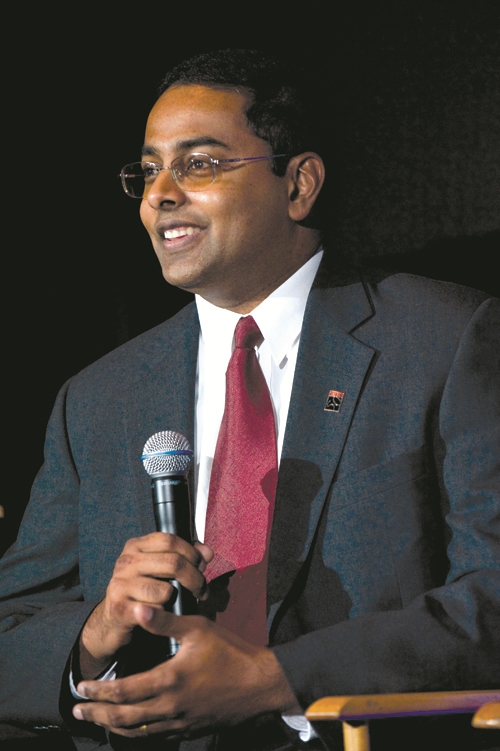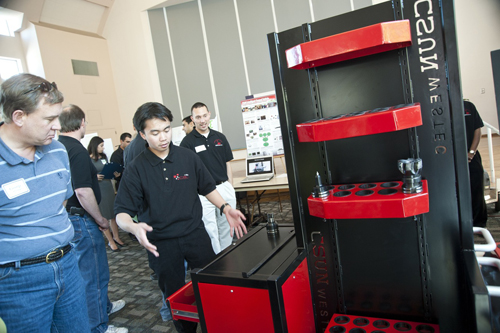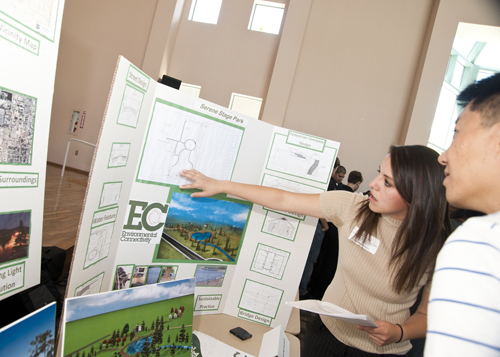Students bridge time and distance with RGS system
The CECS computer labs open at 8 a.m. and close at 10 p.m., remaining closed on weekends. For students engaged in complex projects, particularly those requiring collaboration among members of a team, it can be a major challenge to get their design work done during the labs’ weekday hours, particularly amid fierce competition for the college’s high-end workstations. Now, thanks to a partnership with HP, the computer lab hours have been expanded virtually.
Several years ago, Stewart Prince, professor of mechanical engineering, who was then the faculty advisor to the Formula SAE race car student team, approached Emil Henry, the college’s manager of information systems, about providing students with remote access to the CECS workstations. So Henry began searching for software that would make it possible for them to use graphics-heavy programs like Solidworks remotely via a broadband cable or DSL connection from home. The solution he found was HP’s Remote Graphics Software (RGS) in combination with HP Session Allocation Manager (SAM). The software is used extensively in the financial industry, which usually runs it off expensive blade computers, but CSUN’s proposal, which called for repurposing the existing labs, was novel, and HP agreed to provide 300 licenses for the software for a nominal fee, in exchange for a case study about the project.
 By all measures, the system has been an unqualified success. Because it allows all processing to be done on the CSUN workstations, once students access the system through a VPN connection, it’s almost as if they are working onsite, with the computers processing an impressive 9 frames per second, compared with 15 frames per second locally.
By all measures, the system has been an unqualified success. Because it allows all processing to be done on the CSUN workstations, once students access the system through a VPN connection, it’s almost as if they are working onsite, with the computers processing an impressive 9 frames per second, compared with 15 frames per second locally.
“Students love it,” says Henry. “They can run a high-end CAD application from home and do everything the workstation is capable of, even if they’re working from a slow, outdated PC. “It’s helping students who wouldn’t be able to complete their projects otherwise, and it’s helping us stretch our budget.”
HP has also been paying close attention to the project, recruiting Henry for a remote presentation about the system for a conference at Colorado State University and including him in a press launch for a new HP College Spotlight workstation. The company recently completed a video about the CSUN RGS project, featuring CECS dean S. K. Ramesh, Prince, Henry, mechanical engineering professor Susan Beatty and engineering students.
“RGS and SAM allow students better access to powerful workstations and legitimate software, and the computer labs are better utilized,” says Henry. “It’s a win-win situation for all.”
Watch the video at http://www.ecs.csun.edu/ecs/videogallery15.html.
To read the HP case study, see http://www.ecs.csun.edu/ecs/docs/csun_HP.pdf.
Area companies “test-drive” future employees through Honors Co-Op
CECS students have always known that it pays to work hard and get good grades, but the college’s Honors Co-Op program adds an especially powerful incentive for those with the requisite GPA: a paid internship that just may lead to a permanent job.
“Ninety percent of our co-op students get a job offer from the companies they’re working for, even in this economy,” says Bruno Osorno, professor of electrical and computer engineering and the Honors Co-Op director. “They prove themselves. And the companies have an added value knowing that these engineers and computer scientists can do the job.”
Each year, the college invites undergraduates with a GPA of at least 3.0 and graduate students with a 3.5 GPA to apply for the Honors Co-Op. All must have at least a year until graduation, and undergraduates must have attained junior standing. Those who are interested take part in resume writing and interviewing workshops.
Companies seeking Honors Co-Op interns pay a fee to support the program and gain access to the college’s top students. They submit a job description, and the college matches applicants to the job, creating a small pool of finalists for the company to interview.
The students who are selected then complete a one-year internship, spending two semesters working half time and one summer working full time. In addition to their salaries, students earn 6 units and are graded on their performance. Each November, Honors Co-Op students also take part in a breakfast competition, giving presentations about their projects. All participating companies, past and present, are invited to attend, and the students compete for prizes.
More than once, Honors Co-Op students have so impressed their supervisors that they have been offered full-time jobs before completing their internships.
“Three years ago, Amgen wanted to hire two interns through the co-op,” recalls Osorno. “They hired a student and he started working for them in the summer. I received a phone call in October from the HR person, who said they wanted to hire him full-time. He was doing such a great job that they didn’t want to lose him.”
Osorno talked to the student and the dean and made sure that Amgen was going to help him graduate. “He did graduate and is one of their superstars, and now he comes back and hires the Honors Co-Op students,” he says.
And what of the students who don’t take jobs with their Honors Co-Op employers after completing the internships? “It’s often because they get better offers from other companies,” Osorno explains.
The college is always interested in recruiting companies to become part of the Honors Co-Op. For more information about hiring Honors Co-Op students, please call 818.677.2146 or visit http://www.csun.edu/~ecscoop.
Inaugural Project Showcase puts seniors in the spotlight
 Designs for robots, race cars, aircraft, a sustainable park, software-defined radio, an iPhone app, a campus social networking Web site, a grapeseed oil press and a tool cart — these are just some of the student projects that were on display at CECS’s
Designs for robots, race cars, aircraft, a sustainable park, software-defined radio, an iPhone app, a campus social networking Web site, a grapeseed oil press and a tool cart — these are just some of the student projects that were on display at CECS’s
The event consisted of two parts: a demonstration, where student teams presented their projects and showed what they were supposed to do, and a competition, where they had 15 minutes to describe their projects before a panel of judges. The first-, second- and third-place winners received prizes.
 Although the showcase proved popular with students, faculty, alumni and members of the community, the industry professionals in attendance were especially enthusiastic. “In general, their response was, ‘We had no idea that you had projects of this complexity, and the scope and breadth were outstanding,’” says Ramesh. “When we go out and recruit judges for the 2011 competition, we’ll have a waiting list.”
Although the showcase proved popular with students, faculty, alumni and members of the community, the industry professionals in attendance were especially enthusiastic. “In general, their response was, ‘We had no idea that you had projects of this complexity, and the scope and breadth were outstanding,’” says Ramesh. “When we go out and recruit judges for the 2011 competition, we’ll have a waiting list.”
The next Project Showcase, in spring 2011, will be a daylong event, ideally with corporate sponsors and visits from students at the college’s partner high schools.
“I expect it to get bigger and better and eventually lead to more visibility for the program and opportunities for graduates,” says Ramesh. “It’s very empowering to students—to showcase among themselves and to demonstrate the knowledge, skills and abilities they bring to industry.”
